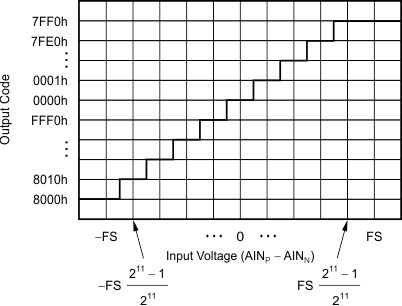SBAS741B October 2015 – April 2020
PRODUCTION DATA.
- 1 Features
- 2 Applications
- 3 Description
- 4 Revision History
- 5 Device Comparison Table
- 6 Pin Configuration and Functions
- 7 Specifications
- 8 Detailed Description
- 9 Application and Implementation
- 10Power Supply Recommendations
- 11Layout
- 12Device and Documentation Support
- 13Mechanical, Packaging, and Orderable Information
8.5.6 Data Format
The ADS1018-Q1 provides 12 bits of data in binary twos complement format that is left justified within the 16-bit data word. A positive full-scale (+FS) input produces an output code of 7FF0h and a negative full-scale (–FS) input produces an output code of 8000h. The output clips at these codes for signals that exceed full-scale. Table 3 summarizes the ideal output codes for different input signals. Figure 12 shows code transitions versus input voltage.
Table 3. Input Signal versus Ideal Output Code
| INPUT SIGNAL, VIN
(AINP – AINN) |
IDEAL OUTPUT CODE(1) |
|---|---|
| ≥ +FS (211 – 1) / 211 | 7FF0h |
| +FS / 211 | 0010h |
| 0 | 0 |
| –FS / 211 | FFF0h |
| ≤ –FS | 8000h |
(1) Excludes the effects of noise, INL, offset, and gain errors.
 Figure 12. Code Transition Diagram
Figure 12. Code Transition Diagram